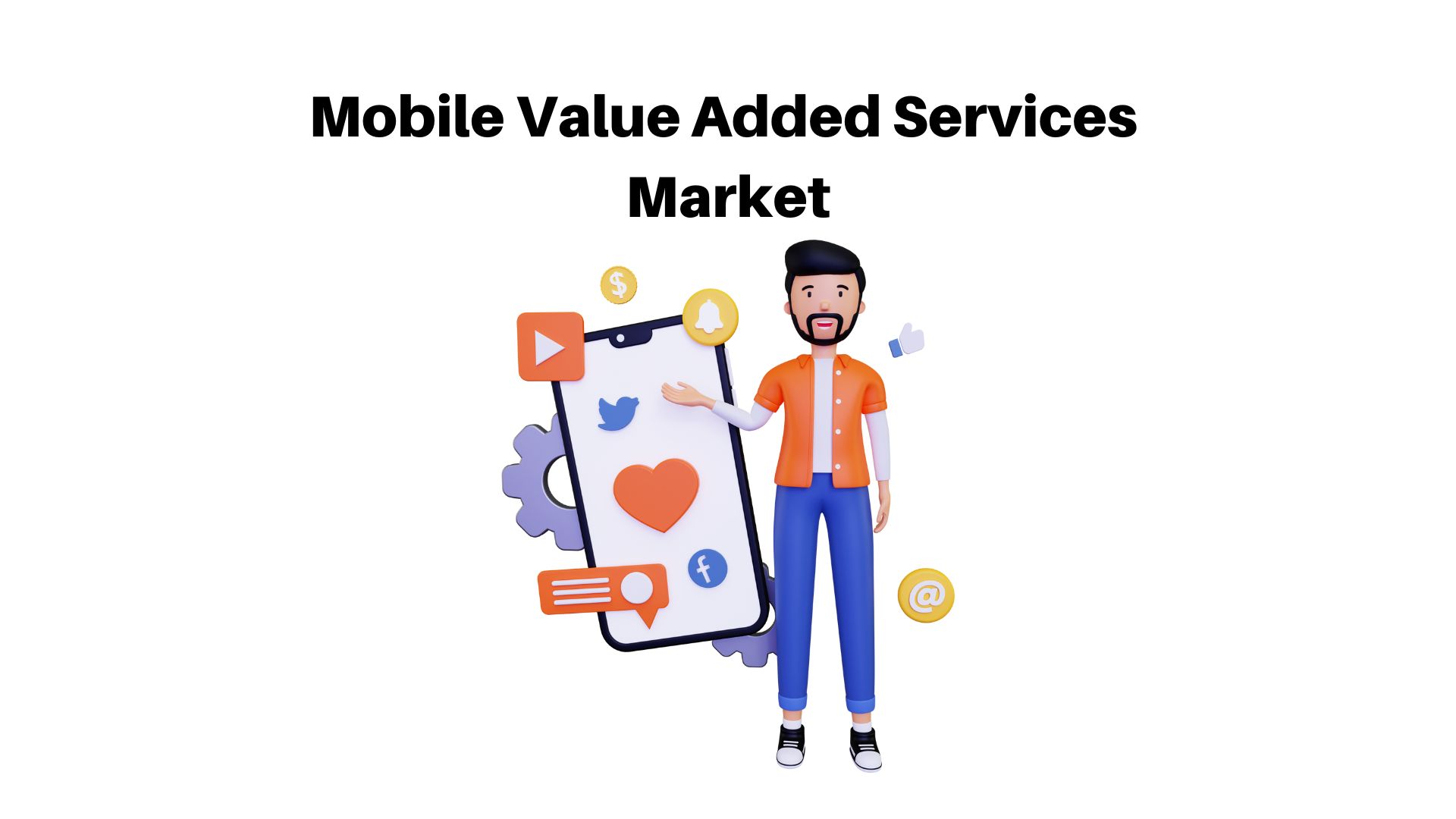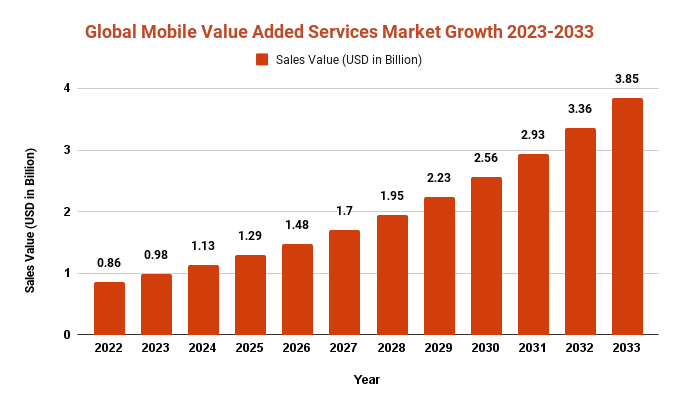Mobile Value Added Services Market To Make Great Impact USD 3.85 Bn In Near Future by 2033

Page Contents
Market Overview
Published Via 11Press: Mobile Value Added Services (MVAS) are services provided by mobile network operators (MNOs) beyond standard voice and messaging offerings. MVAS offer added value to users while creating additional revenue streams for MNOs, and can be delivered through various channels such as SMS, USSD, mobile apps, or web based applications. Mobile Value Added Services Market encompass a broad range of solutions like mobile banking, payments, entertainment, advertising and healthcare which often work in collaboration with third-party providers like banks or content providers.
The Global Mobile Value Added Services market represented USD 0.86 Bn in 2022 and will anticipate around USD 3.85 Bn by 2033 projected around CAGR of 14.6% amid forecast frame of 2023 to 2033.
Mobile virtual assistants (MVASs) have become an essential element of the mobile ecosystem, offering MNOs additional revenue streams and providing users with convenience and functionality. In many emerging markets, MVAS are also seen as a key driver of mobile adoption and usage since they give users access to services previously unavailable.
Key Takeaways
- The Mobile Value Added Services Market expected to reach USD 0.86 Billion in 2022.
- Forecasted compound annual growth rates between 2022 and 2032 is 14.6%.
- By 2032, the Mobile Value Added Services Market is projected to reach USD 3.85 Billion.
- Mobile Virtual Assistant Services (MVASs) are additional offerings provided by mobile network operators beyond standard voice and messaging offerings.
- MVAS provide users with added value and mobile network operators with additional revenue streams.
- MVAS services can be delivered through various channels such as SMS, USSD, mobile apps and the web.
- Mobile Virtual Assistance Systems (MVASs) offer a diverse array of services such as mobile banking, payments, entertainment, advertising and healthcare.
- MVAS services are typically provided in cooperation with third-party providers such as banks, content providers, and healthcare service providers.
- MVAS have become an integral component of the mobile ecosystem, offering MNOs additional revenue streams and giving users greater convenience and functionality.
- MVAS are an important driver of mobile adoption and usage in many emerging markets, giving users access to services that were previously inaccessible.
- MVAS are expected to remain increasingly important as the mobile industry develops, offering new services and technologies tailored to users' evolving needs.

Request Mobile Value Added Services Sample Report: https://marketresearch.biz/report/mobile-value-added-services-market/request-sample/
Regional Snapshot
- North America is a well-established market for mobile financial services (MVAS). Mobile banking and payments are the two most popular services offered while mobile advertising is expected to surpass $100 billion by 2023.
- Europe is a well-established market for mobile financial services (MVAS). Mobile banking and payments have become widely adopted throughout the region while mobile entertainment such as gaming and streaming services has seen an uptick.
- Asia-Pacific is the leading market for Mobile Virtual Assistants (MVASs), thanks to high mobile adoption rates in countries like China and India. Mobile payments, entertainment, and healthcare are among the most sought-after services in this region.
- Latin America is rapidly becoming a hub for mobile financial services with mobile banking and payments topping the list of popular services. Furthermore, the region is witnessing growth in mobile entertainment – particularly gaming on smartphones.
- The Middle East and Africa are rapidly becoming a hub for mobile financial services (MVAS) with mobile banking and payments leading the pack. Furthermore, mobile healthcare services are seeing growth across the region as they provide improved access to healthcare in remote areas.
Enquire with our industry specialist: https://marketresearch.biz/report/mobile-value-added-services-market/#inquiry
Drivers
- Mobile phone users now have access to more offerings and content through cellular phones, which has further inspired the adoption of MVAS.
- Users can get right of entry to services and facts from their phones the usage of mobile digital assistants (MVASs).
- Digital payments are on the upward push as customers seek quicker and safer ways to buy goods.
- Mobile healthcare is becoming extra commonplace, particularly in rural areas the place humans are searching for new methods to get entry to healthcare statistics and services.
- Due to the growing want for cell amusement solutions like gaming and streaming, demand has grown for these types of solutions.
- The Internet of Things (IoT), 5G synthetic intelligence and new cellular virtual assistants (MVASs) have enabled the introduction of new cell virtual aids (MVASs), which take advantage of these developments to provide stronger services and capabilities.
Restraints
- In some regions, especially rural ones, limited network coverage may make it difficult for users to access MVAS. Many may be unaware of their existence or benefits, which could reduce adoption rates. As many MVAS involve sensitive personal and financial data, security concerns could also pose a barrier. If people perceive them to be insecure, they may hesitate to use them. In certain jurisdictions regulatory barriers may further hinder development and adoption of MVAS–particularly in mobile payments and mobile banking–particularly within these specific industries.
- Some MVAS, such as mobile healthcare, may lack the infrastructure needed in certain regions, which may limit adoption rates. Furthermore, the market for these MVASs may be fragmented with many providers offering similar services which may cause confusion among users and lower adoption rates. Furthermore, certain MVAS requiring extra hardware or software may be expensive which also inhibits growth – particularly among users in emerging markets.
Opportunities
- Emerging markets present an enormous potential for mobile virtual assistants (MVAS), where mobile adoption rates are high and there is a growing demand for new services and capabilities. Technologies like IoT and 5G are propelling the development of new MVAS that utilize these resources to offer new services such as connected cars smart homes, and industrial IoT. Furthermore, digital payments have created exciting new possibilities in mobile payments and banking services particularly in developing nations where traditional banking infrastructure may not exist yet.
- Mobile healthcare services are becoming more and more popular, particularly in regions with limited healthcare access. There is great potential for new services and applications to emerge within this space. Mobile advertising is also growing rapidly, giving MVAS providers an opportunity to deliver targeted advertising campaigns and promotions directly to users. Furthermore, the growth of mobile gaming and streaming platforms presents entertainment providers with new opportunities as users look for new ways to access and consume content on their phones.
Challenges
- The MVAS market is highly competitive, with many providers offering similar services. This can make it challenging for new providers to break in and existing ones to differentiate themselves. User adoption may be an issue in regions with little awareness or understanding of MVAS; providers may need to invest in marketing and education initiatives to encourage takeup. Monetization may prove challenging for MVAS providers who offer their services free or at low costs; providers may need to explore alternative business models such as advertising or data monetization to generate income streams.
- Regulatory barriers can hinder the growth and adoption of mobile payment and banking services, particularly where sensitive personal or financial information is involved. To address security concerns, providers may need to invest in security infrastructure as well as adopt best practices. Furthermore, in certain regions the infrastructure required for certain MVAS such as mobile healthcare may not exist yet, leading to lower adoption rates; hence they need collaboration with governments and other stakeholders on infrastructure improvements.
Market Segmentation
Segmentation by Solution:
- Location-based Services
- Short Message Service (SMS)
- E-mail & IM (Instant Messaging)
- Multimedia Messaging Service (MMS)
- Mobile Advertising
- Mobile Money
- Mobile Infotainment
Segmentation by End-Use:
- Enterprise
- Consumer
Segmentation by Vertical:
- Banking, Financial Services and Insurance (BFSI)
- Government
- Education
- Media & Entertainment
- Retail
- Healthcare
- Telecom & IT
Key Players
- AT&T Inc.
- Apple Inc.
- Google LLC
- Vodafone Group PLC
- One97 Communications Limited
- InMobi Pte Ltd.
- OnMobile Global Limited
- Mahindra ComViva
- Kongzhong Corporation
- ZTE Corporation
Report Scope
| Report Attribute | Details |
| Market size value in 2022 | USD 0.86 Bn |
| Revenue forecast by 2033 | USD 3.85 Bn |
| Growth Rate | CAGR Of 14.6% |
| Regions Covered | North America, Europe, Asia Pacific, Latin America, and Middle East & Africa, and Rest of the World |
| Historical Years | 2017-2022 |
| Base Year | 2022 |
| Estimated Year | 2023 |
| Short-Term Projection Year | 2028 |
| Long-Term Projected Year | 2033 |
Growing Demand => Request for Customization
Recent Developments
- Rise of super apps: Super apps, which offer a comprehensive selection of MVAS (multiple value added services), are becoming increasingly popular in some regions, particularly Asia. These applications integrate various services like payments, messaging and entertainment onto one platform for convenience.
- AI and Machine Learning Are Being Utilized: AI and machine learning are increasingly being applied to create new mobile virtual assistants (MVAS), such as personalized recommendations or predictive analytics. These technologies can improve user engagement while driving revenue growth.
- Growth of mobile gaming: Mobile gaming is rapidly expanding, and many MVAS providers are entering this space. Some providers are also exploring new business models such as subscription-based gaming services.
- Expansion of Mobile Payments: Mobile payments are becoming more commonplace particularly in emerging markets. Some providers are expanding their existing offerings to include features like remittances and bill payments.
- Emergence of Mobile Healthcare: Mobile healthcare is an emerging market, and many MVAS providers are exploring new services in this space such as telemedicine and health tracking.
- Focus on user privacy: With rising concerns regarding user privacy, many MVAS providers are working to build more secure and transparent services. This includes adopting best practices in data handling and encryption, as well as giving users more control over their data.
Key Questions
1. What are Mobile Value Added Services (MVAS)?
Mobile Value Added Services (MVAS) refer to non-core applications provided by mobile network operators that enhance user experience. Examples include payments, messaging, entertainment and healthcare on mobile.
2. How are MVAS different from traditional mobile services?
MVAS are non-core applications that supplement core mobile functions like voice and data. While traditional mobile services focus on connectivity, MVAS aim to improve user experience and add additional value.
3. What are the Benefits of MVAS?
MVAS can offer several advantages to mobile network operators, such as increased user engagement, enhanced customer satisfaction levels and additional revenue streams.
4. What are some examples of Mobile Virtual Assistance Services (MVASs)?
Examples include mobile payments, banking, entertainment (such as music or video streaming), messaging, advertising, and healthcare.
5. What are some challenges confronting the MVAS market?
Major difficulties include competition, user adoption, monetization, regulation, security measures and infrastructure limitations.
6. How is the MVAS market evolving?
The MVAS market is rapidly developing, with new services and capabilities appearing daily. Providers that can stay ahead of these advancements and adjust according to user needs will be well-positioned for success in years ahead.
Contact us
Contact Person: Mr. Lawrence John
Marketresearch.Biz (Powered By Prudour Pvt. Ltd.)
Tel: +1 (347) 796-4335
Send Email: [email protected]
The team behind market.us, marketresearch.biz, market.biz and more. Our purpose is to keep our customers ahead of the game with regard to the markets. They may fluctuate up or down, but we will help you to stay ahead of the curve in these market fluctuations. Our consistent growth and ability to deliver in-depth analyses and market insight has engaged genuine market players. They have faith in us to offer the data and information they require to make balanced and decisive marketing decisions.